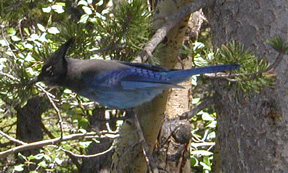Intelligence
To understand animal intelligence, we need to define intelligence. This is nearly impossible for humans, and may indeed be impossible, in a general sense, for animals. In humans we usually think of intelligence as being composed of:
- ability to learn
- speed of learning
- ability to solve problems
- speed of recall of learned material
Of course, there's considerable cheerleading for humans to be the most intelligent animal species on the planet, so we probably choose definitions of intelligence, and ways of testing intelligence, which "prove" this point. There's a humorous side to seeing us do this, but there's also a serious and dark history to intelligence testing in humans, which has been all too often geared to "prove" the superiority of a racial, ethnic, or gender group.
Its probably better to focus on the components of intelligence, rather than trying to devise measures of general intelligence, particularly if the goal is to generate cross-species comparisons. Learning ability in many animals is quite context-specific. For example, a bird species may be a champion at learning and remembering where it has cached food, but be rather dull at other tasks.
 |
A steller's jay, Cyanocitta stelleri, a common bird in mountain habitats of the western United States. The steller's jay is able to foil ingenious devices to keep it out of camp food, and it is an aggressive predator on the eggs of other birds. Its ability to gain food in the face of strong defenses has gained this species a reputation for cleverness. |
Birds in the family Corvidae--crows, ravens, magpies, jays and their relatives--have a reputation for high intelligence. Humans have this impression because these birds are adept problem solvers, good at caching and finding food, and they even seem to have a sense of human. There is much to admire about corvid behavior--consider this natural history description: "On the morning of January 15, 1938 I saw a coyote trotting along the base of Mount Everts on the margin of a wide flat. Across the flat a raven was standing on a snow-drift. When the coyote had trotted to a point opposite the raven, about 200 yards away, it turned its course directly toward the bird. By that time, a second raven had alighted beside the first one to feedon a tiny food morsel it had been carrying. When the coyote was somewhat less than ten yards from the feeding raven, it made a quick dash. The raven easily escaped and lit again a few yards to one side. The coyote sniffed the spot where the raven had been feeding and then made another dash for it. These tactics were repeated six or seven times before the bird flew off about 250 yards. After peering at the departing bird, and seeming to hesitate whether or not to follow, the coyote trotted after it. When the coyote had covered half the distance, the raven circled back, wheeling fifteen or twenty feet over the coyote, which looked up. "The raven lit on the snow again to feed on its morsel, and the coyote trotted along as if to pass it, but suddenly turned to make another quick charge. The rushes, as before, were repeated five or six times. Once the coyote leaped high in the air toward the raven and rolled over twice when it hit the snow. The raven finally flew away along the river and the coyote disappeared in a draw. It appeared that both animals were enjoying the fun, for the raven could easily have flown away to escape if it were annoyed, and it would seem that the coyote, which was probably well fed by the abundant carrion, would not have been so persistent unless he were enjoying the play." (Adolph Murie, Ecology of the Coyote of the Yellowstone, US Government Printing Office, 1940, public domain, pp 33-34) The behavior is so human-like, on the part of both the raven and the coyote, that it is hard not to conclude that these are thinking, intelligent animals. Whatever the case may actually be, the account is charming. |
|
Macphail EM, Bolhuis JJ 2001. The evolution of intelligence: adaptive specializations versus general processes. BIOLOGICAL REVIEWS 76 (3): 341-364 AUG